Guns in America: 16 Charts You Need to See
Updated: Aug. 18, 2023
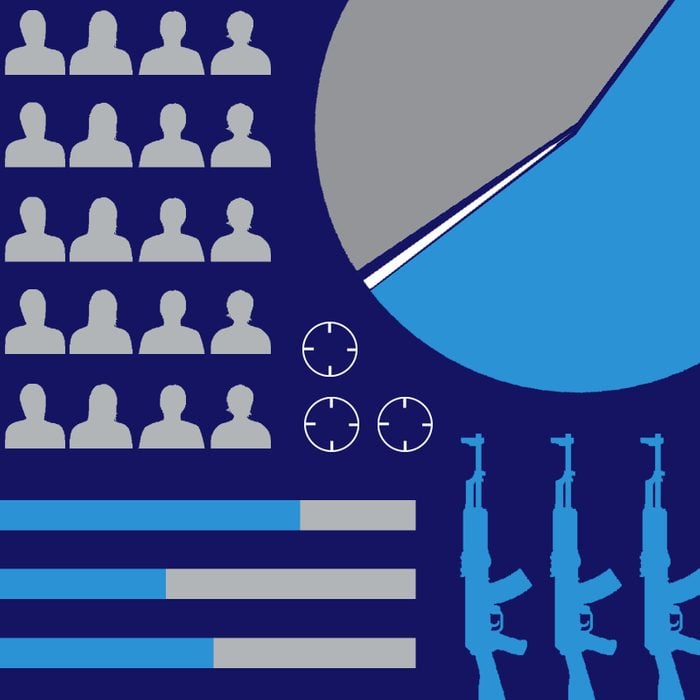
While it’s clear that America has a gun violence problem, these staggering statistics shed new light on just how pervasive it is
June 3, 2022, was National Gun Violence Awareness Day. By then, there were already 235 mass shootings in the United States since the start of the year. If that pace continues, there will be 586 mass shootings in America by New Year’s Eve. As shocking as those gun violence statistics are, they would be an improvement over the prior two years. According to the Gun Violence Archive, there were 692 mass shootings in 2021, and 610 in 2020. And these numbers don’t include the roughly 20,000 other gun homicides, 25,000 gun suicides and 115,000 non-fatal gun injuries—including the 18,000 children shot and killed or wounded every year.
Gun violence doesn’t just affect the victims. The trauma also impacts survivors, their families and their communities, as well as society at large. Too often we can develop “trauma fatigue”—even as we’re trying to help the victims and families of shootings and do our part to prevent school shootings and gun violence in general—which makes us feel helpless in the face of the relentless violence. While the American Psychological Association recommends that we acknowledge our feelings, it’s also important to try to understand what’s happening and why it’s so hard to stop gun violence in America. After all, while gun violence isn’t a uniquely American phenomenon, what does seem particular to this country is the dizzying rate at which it happens and the lack of action by legislators, which is in stark contrast to how other countries respond to mass shootings.
The following statistics paint a very clear picture of the gun violence we’re facing in this country and how we can take action to help lessen it.
How many people die from gun violence each year?
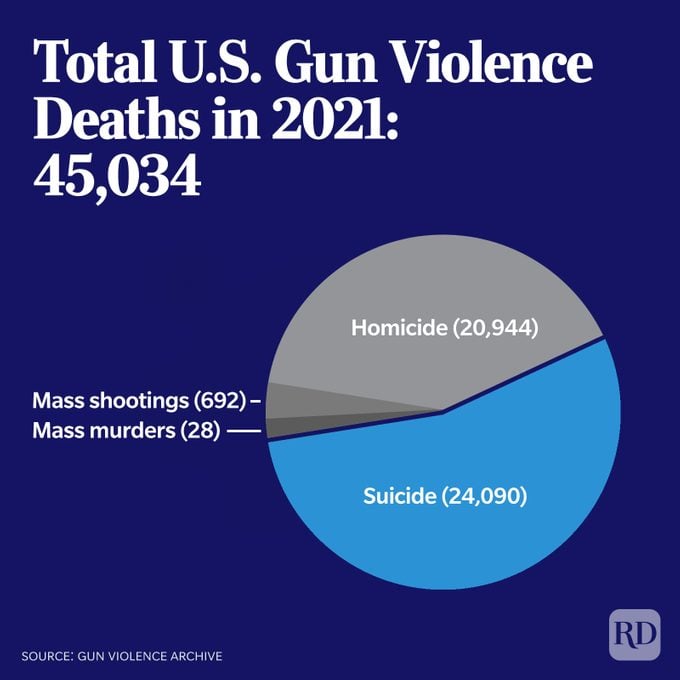
While mass shootings gain national attention, and deservedly so, they are responsible for just a small fraction of gun violence in America. It’s important to remember that gun deaths also include homicides, suicides, accidental shootings and other tragedies affecting thousands of families across the country.
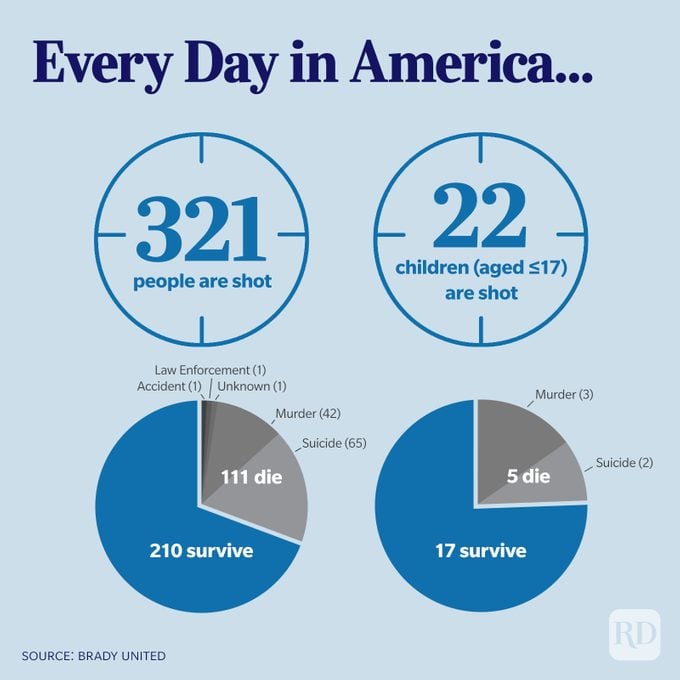
Every day in America, an average of 321 people are shot, according to Brady United. Of that number, 111 die: 42 are murdered and 65 die by suicide; one is shot and killed by accident, another is shot by law enforcement and another dies of an undetermined cause.
The gun violence statistics are even more grim when it comes to kids: Every day, 22 children aged 17 and under are shot. Five die, three of them murdered and two killed by suicide. Eight are shot by accident and survive, and eight are shot by a gun left unsecured and unattended at home. Gun reform advocates say that these numbers could be greatly reduced if Congress passed a few key commonsense gun laws.
How much damage does gun violence cause?
A helpful measure of the extent of the damage gun violence causes in America is how it compares with other occurrences in everyday life, from car accidents to cancer.
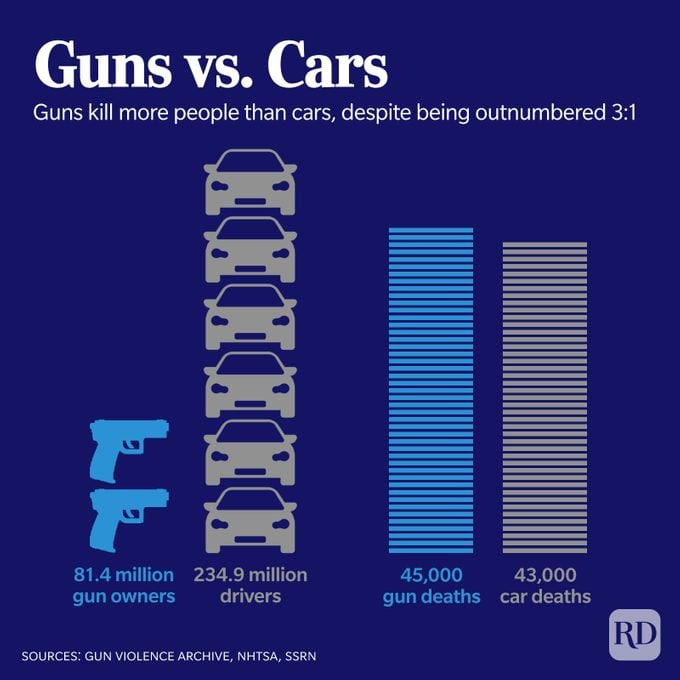
In 2021, 45,034 people died by gunfire, while 42,915 died in motor vehicle accidents. While these numbers may seem comparable, they’re more lopsided than you might realize, since car owners far outnumber gun owners: There are an estimated 234.9 million licensed drivers—and only 81.4 million gun owners.
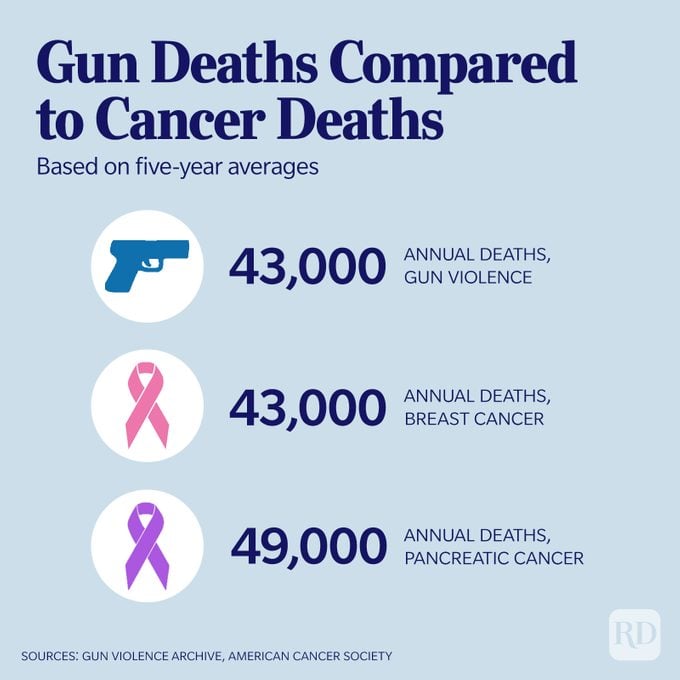
The number of Americans killed by guns annually (about 43,000) is on par with those who die from breast cancer (43,000) and pancreatic cancer (49,000), according to the American Cancer Society. These numbers are based on five-year death averages.
Are guns the problem?
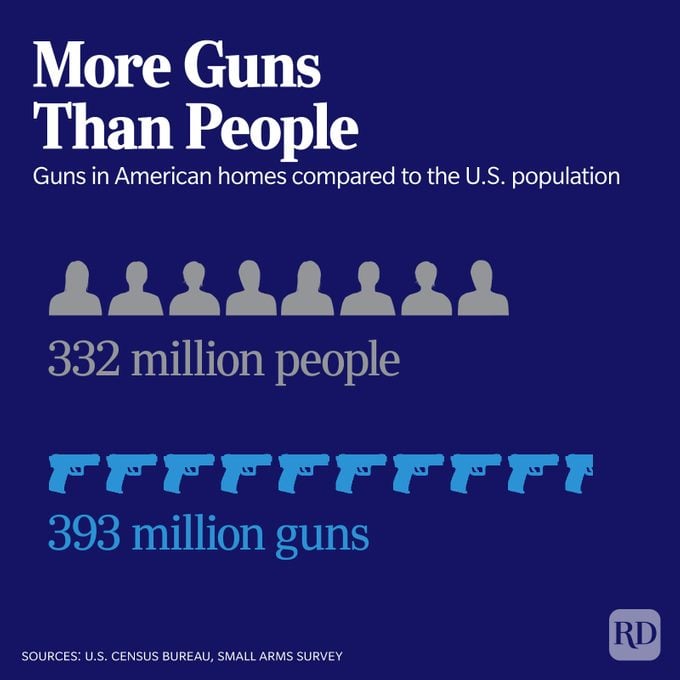
In 2018, the Small Arms Survey reported that Americans collectively own 393 million guns. That’s more guns than America has people. The population of the United States stood at 332 million in 2021, according to the U.S. Census Bureau. While the number of new guns since 2018 can’t be determined precisely, about 21.5 million guns were legally purchased in America in 2020, and almost 19 million were bought in 2021.
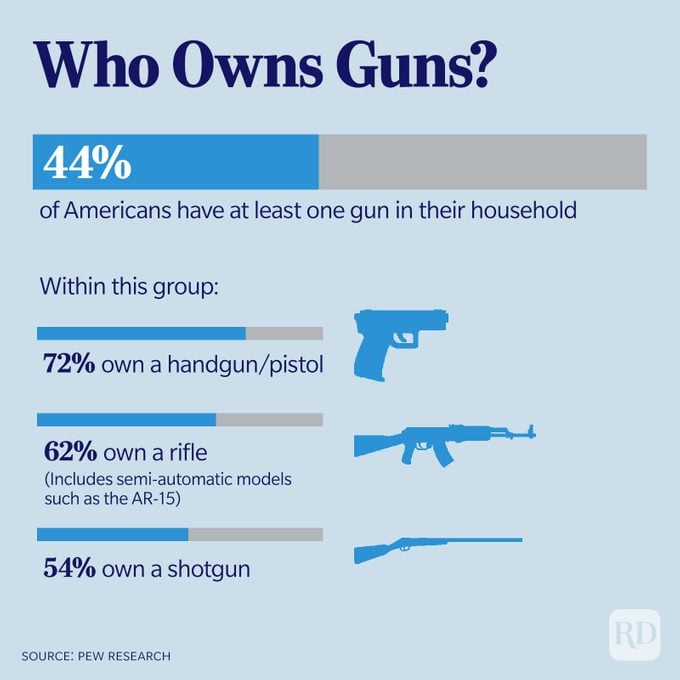
In 2020, 44% of Americans reported that they or someone in their household owned a gun, per an annual Gallup poll on guns in America. The typical American gun owner is White, male, between the ages of 30 and 64, has a household income of less than $100,000, lives in the suburbs or a rural area and is registered to vote as a Republican.
About two-thirds of gun owners have more than one firearm, and, at least statistically speaking, the average gun owner has eight firearms.
Most gun owners have a handgun or pistol (72%). The next most popular firearm is a rifle, including semi-automatic (62%), followed by a shotgun (54%). Since the federal assault weapons ban lapsed in 2004, AR-15 military-style rifles have become one of the most popular weapons among gun enthusiasts, with about 20 million in circulation in the United States.
About 40% of gun owners have at least one gun that is loaded and easily accessible to them at all times, and 63% say they have at least one gun that is never locked up.
Does having more guns make us safer?
If the gun lobby is correct, more guns in society makes for a safer society. But gun violence statistics tell a different story. Researchers at Stanford University found states that adopted right-to-carry concealed handgun laws saw their violent crime rates increase by 13% to 15% within 10 years. And according to the Giffords Law Center to Prevent Gun Violence, states with stricter gun regulations have fewer gun deaths per capita, while states with looser gun laws have much higher rates of gun deaths.
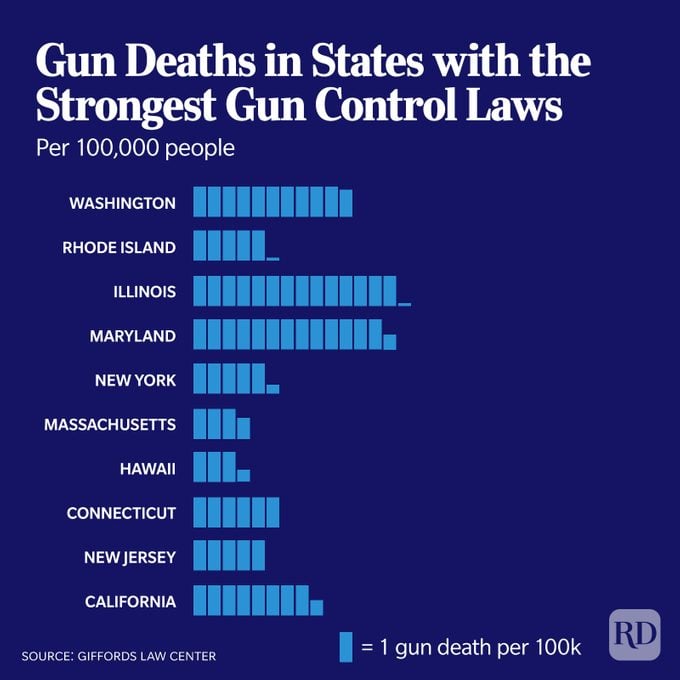
Gun rights advocates frequently point out Illinois as an example of a state with strict gun laws that nevertheless has a relatively high occurrence of gun violence. However, that’s only part of the story: The state’s largest city, Chicago, is just a short drive from the borders of Wisconsin and Indiana, two states with comparatively lax gun laws. In fact, last year the city sued a gun store in Gary, Indiana, about 30 miles from downtown Chicago, that had sold more than 850 guns recovered during criminal investigations in Chicago. The same store was linked to 44% of federal gun prosecutions in northern Indiana between 2014 and 2021.
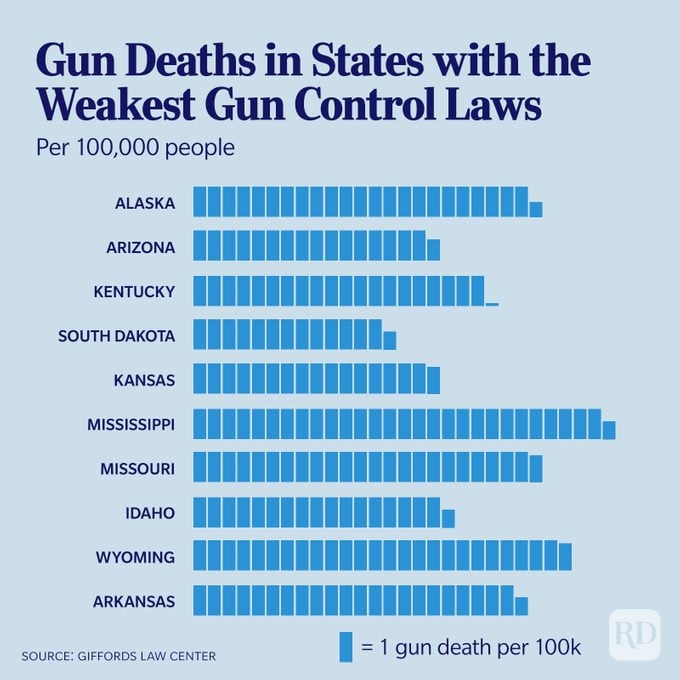
Hawaii ranks fourth on the Giffords list of strictest gun laws, and it’s 50th in the rate of gun deaths, with 3.4 per 100,000 population. At the other end of the scale, Mississippi ranks 45th on the Giffords list and has 28.6 gun deaths per 100,000 people—the worst in the country.
According to David Hemenway, director of the Harvard Injury Control Research Center, the presence of a gun is more likely to make a hostile interaction turn deadly. One study, released in April 2022, found that living with a gun in the house more than doubled the likelihood of being killed by a domestic partner, while a 12-year study published in 2020 in the New England Journal of Medicine found that men who owned guns were three times more likely to die by suicide. Hemenway also notes that according to the National Crime Victimization Survey, about 100,000 people report using a firearm to defend themselves against crime every year, but that number is in line with the use of other weapons in self-defense, such as mace or a baseball bat.
Are mass shootings getting worse?
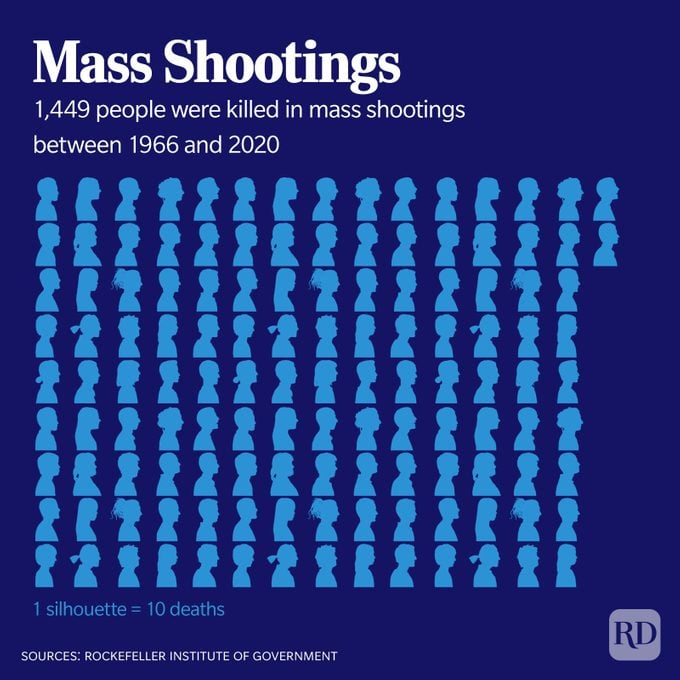
A mass shooting is defined as one in which four or more people are shot in a single event, not including the perpetrator. The first recognized mass shooting in America occurred in 1966, when a sniper at the University of Texas killed 17 people from his perch in a clock tower. Between then and 2020, 1,449 people have been murdered in mass shootings, and an additional 2,141 have been wounded. And here’s another staggering fact: In the 10 years from 1966 to 1975, there were 12 mass shootings; from 2011 to 2020, there were 160. About 30% of mass shootings happen in workplaces, and about 25% occur in schools.
Since 2020, mass shootings have been on the rise, with the Washington Post noting that there have been at least four mass shootings every week in 2022. According to one ex-gunman, here’s how we can stop the next mass shooter.
Are some guns more deadly than others?
Though “assault” weapons tend to make headlines, they were responsible for only 32% of the deaths in mass shootings from 2009 to 2018. At least one handgun is used in an overwhelming majority of mass shootings (81%), and in a smaller majority (60%) of mass shootings, only a handgun is used—but often in combination with a high-capacity magazine.
Though handguns remain the most common type of weapon used in non-mass shootings, accounting for 62% of homicides in 2019, AR-15 and similar semi-automatic weapons cause more deaths more quickly than other types of firearms and were used in the deadliest of America’s mass shootings, including in Las Vegas (58 people killed), Orlando (49 people killed), Newtown, Connecticut (27 people killed, mostly children) and Uvalde, Texas (21 people, including 19 children, ages 10 and 11).
All told, firearms are used in about three-fourths of all homicides, while stabbings cause about one in 10 murders, beatings without weapons cause under 5% and other murders using blunt force weapons, poisonings, fires and explosions make up just over 10%.
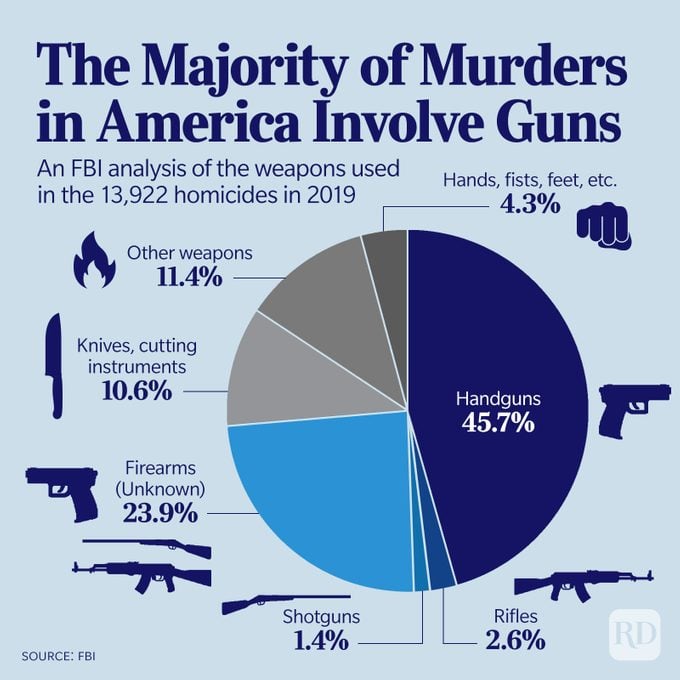
Where does America rank in global gun ownership and violence?
America is armed with 120.5 guns for every 100 residents, whereas the figures for other countries are far lower. The countries with the next-highest rates of gun ownership are Yemen (52.8 guns per 100 people), Serbia (39.1), Montenegro (39.1) and Uruguay (34.7). Canada, our northern neighbor, also has 34.7 guns per 100 people—less than a third of the gun ownership rate in America. In fact, although the United States accounts for 4.4% of the world’s population, we have 42% of the civilian-owned guns in the world. Other countries, such as Italy, also have gun cultures, but mass shootings there are rare, and gun violence statistics are markedly different.
In 2021, the United States ranked 10th among the world’s highest rates of gun deaths, with 12.21 per 100,000 people, behind countries such as El Salvador, Venezuela, Guatemala, Honduras and Jamaica, which struggle with drug trafficking and gang activity, according to Ali Mokdad, a professor of global health and health metrics science at the Institute for Health Metrics and Evaluation. When compared with only high-income countries, the United States ranks first. Even Mexico, our southern neighbor purported to be rife with drug-trafficking gangs, had just 6.34 gun deaths per 100,000 residents in 2021.
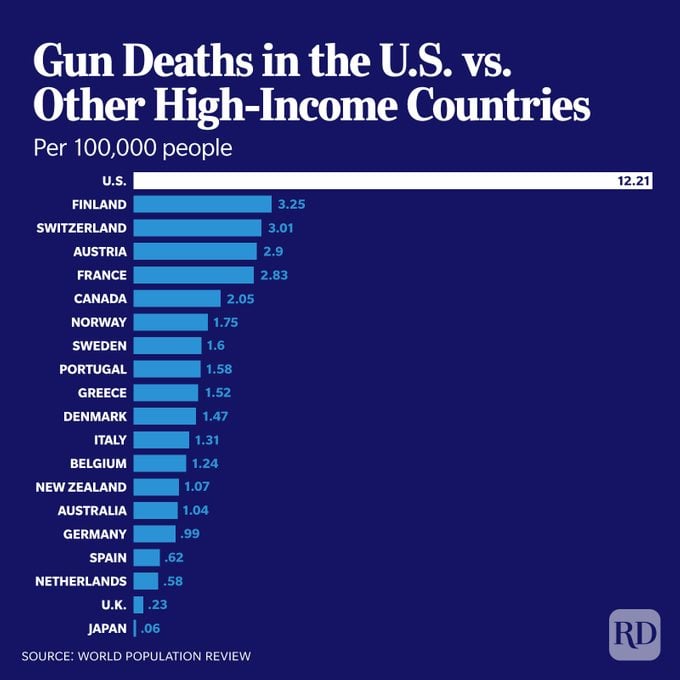
Is mental illness the problem?
Many gun control opponents say that the key factor in gun violence in America is mental illness. In the wake of the Uvalde school shooting in May 2022, Texas Governor Greg Abbott said, “Anybody who shoots somebody else has a mental health challenge.” Mental health experts and criminologists who research mass murderers condemned Abbott’s claim as false and unjustly scapegoating people who suffer from mental illness.
A 2021 Rand Corporation study found that people with mental health problems are no more likely to engage in gun violence than others, and in fact are more likely to be victims of violence than perpetrators. It’s worth noting that other countries have similar rates of mental illness but nowhere near the same level of gun deaths.
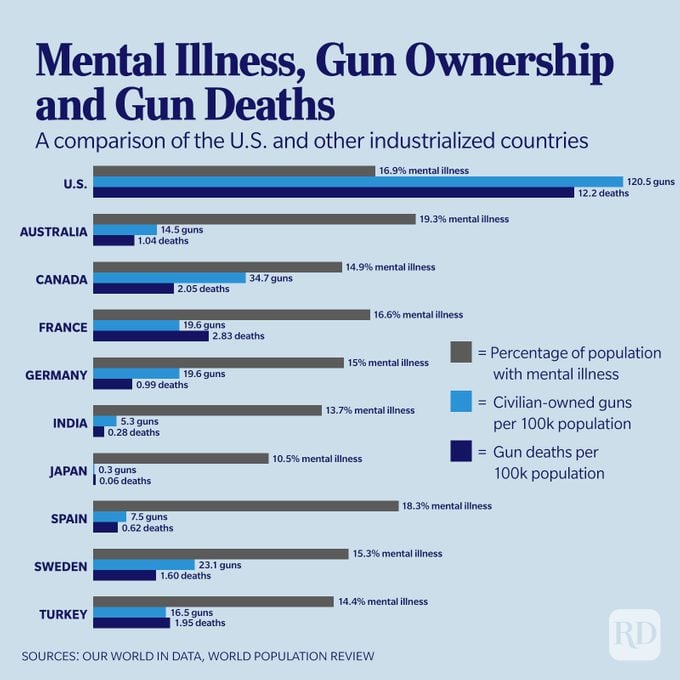
About 17% of Americans suffer from some form of mental illness. That’s about the same as in France, but France deals with fewer than three gun deaths per 100,000 residents, compared with 12.2 gun deaths per 100,000 Americans. And Australia has a more than 19% rate of mental health problems but just 1.04 gun deaths per 100,000. Why does Australia have so few gun deaths while the United States has so many?
In 1996, a gunman killed 35 people and wounded 23 more in a café in Port Arthur, Tasmania. The government responded by passing a sweeping gun law, banning the import and sale of automatic and semi-automatic rifles, instituting a mandatory 28-day waiting period to buy a gun and creating a government buy-back program that took 700,000 guns out of private hands and destroyed them. The result: one mass shooting in 25 years and a 60% drop in gun homicides.
Of course, Australia doesn’t have the Second Amendment to contend with. A far-reaching weapons ban in the United States to match the one in Australia would require amending the Constitution.
What also stands out is America’s passion for guns: 120 of them for every 100 Americans. Even Canada, the closest country on the list, has fewer than 35 guns for every 100 Canadians. Despite sharing American movies, TV, music, video games and other aspects of a culture that firearm enthusiasts often blame for gun violence, as well as having a 15% rate of mental illness, Canada has just 2.05 gun deaths per 100,000 population. No other country’s rate tops two per 100,000.
Almost half of all Americans (44%) know someone who has been shot. Nearly every American will know at least one victim of gun violence during their lifetime. By comparison, the likelihood that any individual will be shot in Singapore—the country with the lowest gun fatality rate in the world—is calculated to be one in a million. In Japan, the odds are two in a million. In America, it rockets to 1,060 in a million.
Who is most affected by gun violence?
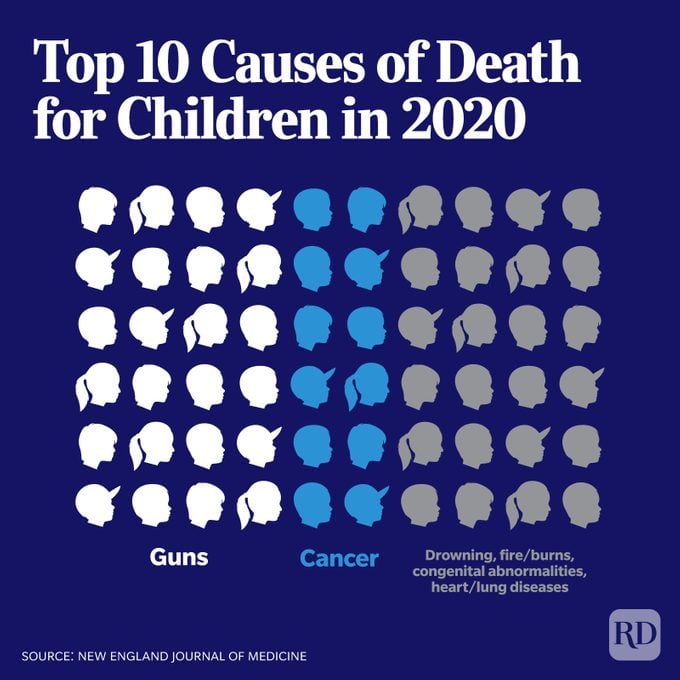
According to the New England Journal of Medicine, guns kill about twice as many kids as cancer, and about as many as drowning, congenital malformations, heart disease, fire-related injuries and lung diseases combined. About a third of households with children have a gun.
Women are also often victims of gun violence. Guns are used in about 56% of intimate-partner homicides, and the victims are overwhelmingly female. Here are more startling facts about domestic violence.
How many people are affected by school shootings?
Survivors of mass shootings and other gun crimes face lifelong trauma, and some of them struggle for many years, while others never fully recover. Often, people who have been shot experience post-traumatic stress disorder, unemployment and drug and alcohol abuse. The American Psychological Association estimates that among those who have survived a mass shooting, around 28% develop PTSD. Those who aren’t shot but witness gun violence up close, as well as loved ones of the victims, are also impacted.
A growing number of gun violence survivors facing lifelong recoveries are children. According to a recent report by the Washington Post, since the 1999 shooting at Columbine High School in Colorado, more than 300,000 children have been traumatized by school shootings.
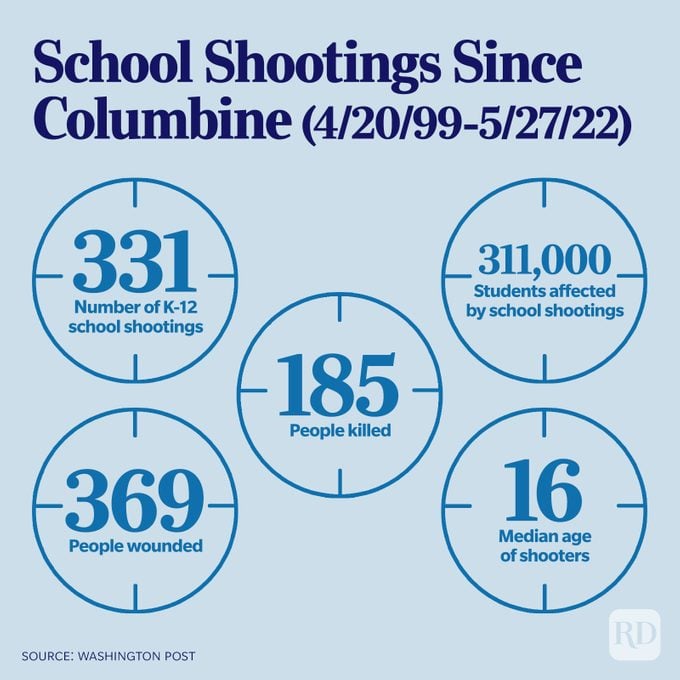
What does gun violence cost, in dollars and cents?
One of the most surprising statistics you learn here may be how gun violence affects America’s economy. A 2019 report from the U.S. Congress Joint Economic Committee concluded that the costs of lost income, employer costs, health care, and police and criminal justice expenses due to gun violence amount to a staggering $229 billion every year. A 2021 study by Everytown for Gun Safety puts the figure at $280 billion annually. Everytown’s numbers include a $34.8 million daily taxpayer tab for medical care, first responders and criminal justice, as well as $1.4 million in economic productivity that employers lose every day when their workers are victims of gun violence.
The chart below shows a few things that the $280 billion Americans spend on gun violence could buy instead.
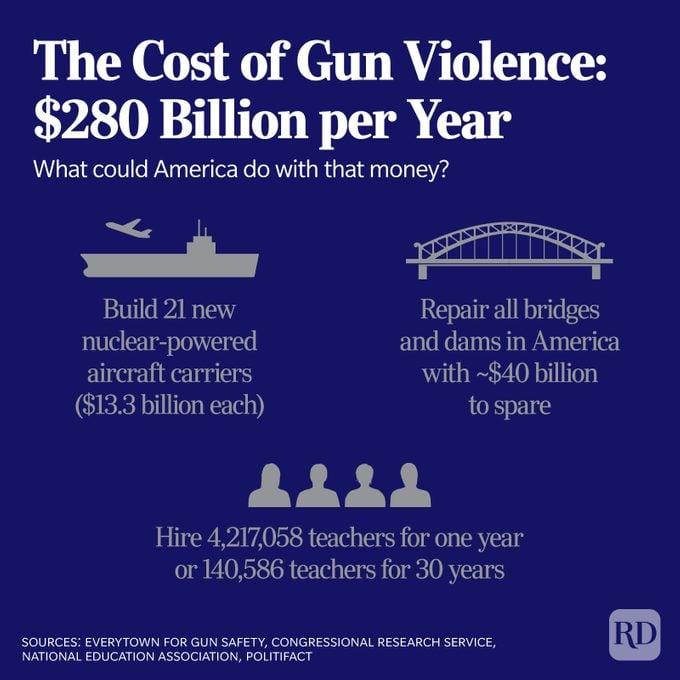
Could gun law reforms keep us safer?
Though Americans have been polarized on many issues in recent years, they almost universally agree on the importance of universal background checks. In a 2021 Quinnipiac poll, 89% of Americans surveyed said they support requiring background checks for all gun sales.
Red flag laws, sometimes known as extreme risk protection orders (ERPOs), let family members or police petition a judge to remove guns from a person they believe to be at high risk for injuring themselves or others. Currently, such laws are on the books in 19 states and enjoy broad support: 77% of Americans want family members to be able to request a red flag intervention, and 70% say police should be able to. President Biden announced in April 2022 that the Justice Department would issue a model red flag law for states to use in creating their own legislation.
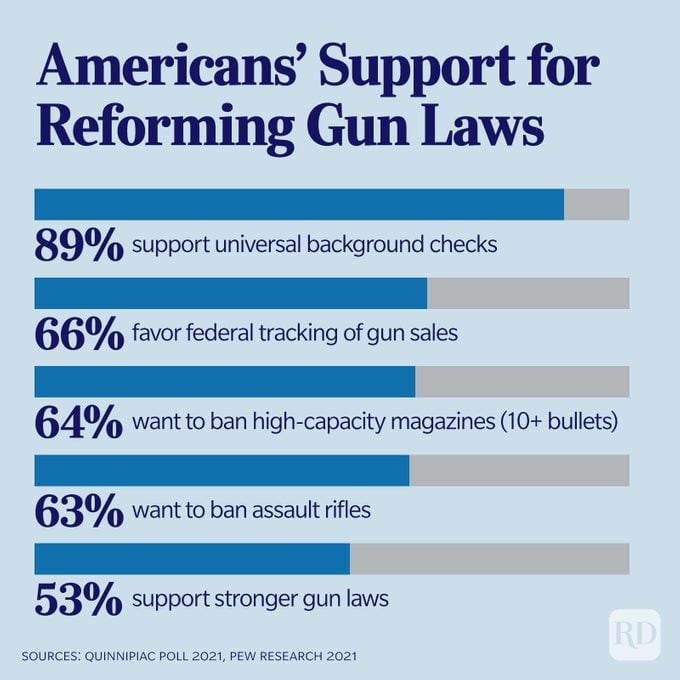
Support for “stricter” laws governing the sale of firearms in general is less robust, however. In 2020, only 57% of people surveyed in a Gallup poll wanted to see laws strengthened—down from 64% the previous year—while 34% want current laws to remain in place. Just 9% of people think gun laws should be less strict than they are now.
Congress recently passed commonsense gun legislation intended to keep us safer. A bipartisan effort, it was signed into law by President Biden on June 25, 2022. While it was less robust than gun control advocates had originally hoped, and a Supreme Court decision that same week expanded gun rights in another arena, it was the first meaningful gun safety legislation since the 1994 assault weapons ban that helped reduce the murder rate during the 10 years it was in effect.
Additional reporting by Laurie Budgar.
Sources:
- Gun Violence Archive
- Pew Research Center: “What the data says about gun deaths in the U.S.”
- UC Davis Health: “Facts and Figures”
- Everytown: “Child & Teen Gun Safety”
- Gallup: “What Percentage of Americans Own Guns?”
- Harvard T.H. Chan School of Public Health: “Do guns make us safer?”
- SafeHome.org: “Guns in the U.S. – 2021 Second-Highest Year for Gun Sales Since 2000”
- New England Journal of Medicine: “Current Causes of Death in Children and Adolescents in the United States”
- Annals of Internal Medicine: “Homicide Deaths Among Adult Cohabitants of Handgun Owners in California, 2004 to 2016”
- New England Journal of Medicine: “Handgun Ownership and Suicide in California”
- Rockefeller Institute of Government: “Mass Shooting Factsheet”
- Rand Corporation: “Is Mental Illness a Risk Factor for Gun Violence?”
- New England Journal of Medicine: “Current Causes of Death in Children and Adolescents in the United States”
- Gallup: “Guns”
- Washington Post: “Gun Violence Since Columbine”
- Everytown: “The Economic Cost of Gun Violence”
- Pew Research Center: “Key facts about Americans and guns”
- Quinnipiac: “Majority Support Stricter Gun Laws, Quinnipiac University National Poll Finds; Stark Divides on Views of Police and Voting Issues”
- Ali Mokdad, professor of global health and health metrics science at the Institute for Health Metrics and Evaluation
- CATO Institute: “Are Mass Shootings Becoming More Frequent?”
- Brady United: “Key Statistics”
- Giffords Law Center: “Statistics”
- FBI: “2019 Crime in the United States”



